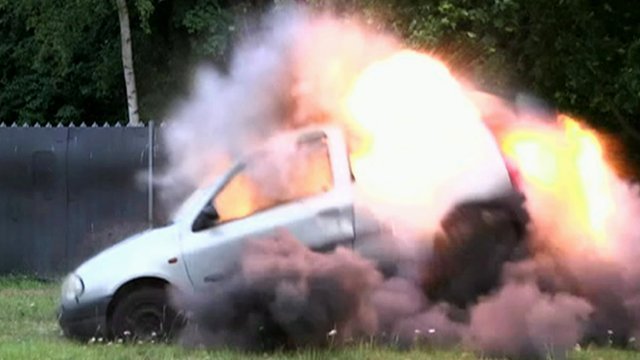How to Blow a Car Up
To blow a car up, one can use explosives placed strategically inside the vehicle. This can be done by a trained professional for safety reasons.
Blowing up a car may seem like something out of a movie, but there are instances where it may be necessary for certain scenarios. Whether for a film production, scientific experiment, or military training exercise, knowing how to properly detonate a car can be crucial.
However, it is important to note that handling explosives is extremely dangerous and should only be done by experts in a controlled environment. We will discuss the methods and safety precautions involved in blowing up a car for various purposes.

Credit: auto.howstuffworks.com
Understanding Car Explosions
Causes Of Car Explosions
Car explosions can occur due to various reasons, often related to a combination of mechanical failures, electrical issues, and external factors.
Types Of Car Explosions
Car explosions can be classified into fuel explosions, electrical explosions, and mechanical explosions. These types can vary based on the specific cause and conditions.
Identifying Potential Targets
To identify potential targets for blowing up a car, one must carefully consider the most vulnerable areas, such as the fuel tank, engine, or electrical system. It’s important to assess the vehicle’s structure and components to determine the most effective method for causing an explosion.
This requires thorough planning and precision.
Identifying Potential Targets When it comes to blowing up a car, identifying potential targets is a critical first step. It is important to select the right car and assess the surroundings before proceeding. In this section, we will delve into these two aspects in detail. Let’s get started!Selecting The Right Car
Choosing the right car plays a vital role in the success of your operation. It is essential to choose a vehicle that meets your objectives and provides the desired impact. Here are a few factors to consider when selecting the right car: 1. Type of Car: Different cars have different vulnerabilities, so it is crucial to choose a car that is susceptible to explosions. Typically, older cars without modern safety features can be more susceptible. 2. Fuel Type: Cars powered by gasoline are generally more explosive compared to electric or hybrid vehicles. Gasoline is highly flammable, which can make it easier to achieve the desired outcome. 3. Location: Consider the location where you plan to carry out the operation. It’s important to choose a car that is suitable for the environment. For example, an SUV might be more appropriate for a rural setting, while a compact car could be more suitable for an urban area.Assessing The Surroundings
Once you have selected the right car, it’s time to assess the surroundings to ensure a safe and effective explosion. Here are a few things to keep in mind: 1. Safety: Ensure that there are no bystanders or innocent individuals in the immediate vicinity. Safety should always be the top priority, so choose a location where the risk of collateral damage is minimal. 2. Accessibility: Consider the ease of approaching and accessing the target car. Inaccessible locations may require additional planning or equipment to ensure a successful operation. 3. Concealment: If secrecy is essential, choose a location where the explosion won’t attract unwanted attention. Preferably, opt for secluded areas where the blast can go unnoticed. Remember, blowing up a car is a dangerous and illegal activity. The content provided here is for informational purposes only and does not endorse or promote any illegal actions. This section serves to educate readers about the considerations involved in identifying potential targets for educational and creative writing purposes. Now that we have covered the importance of selecting the right car and assessing the surroundings, let’s move on to the next section on preparing the explosive device. Stay tuned for more valuable information in our series on explosive techniques.Gathering The Necessary Materials
To properly detonate a car, gather the necessary materials such as explosives, a remote detonator, and safety gear. Preparation is key to ensuring a successful controlled explosion without causing harm or damage to surroundings. Be diligent in acquiring all essential components before proceeding with the detonation process.
Explosives And Detonators
Select high-quality explosives like C4 or dynamite. Acquire detonators, such as time-delay or remote-controlled options.Other Equipment And Tools
Protective gear like goggles and gloves are essential. Get wireless remote controls for safe detonation. Prepare equipment: screwdrivers, pliers, wire cutters, and power sources. – Ensure proper ventilation to prevent accidents. – Follow all safety protocols diligently for a successful operation through preparedness. Always prioritize safety when gathering materials for blowing a car up.
Credit: milwaukeerecord.com
Preparing For The Operation
Before attempting to blow up a car, it’s vital to prepare thoroughly for the operation. This involves creating a detailed plan and ensuring personal safety. By following these steps, you can effectively execute the task while prioritizing safety.
Creating A Detailed Plan
When planning to blow up a car, it’s essential to have a detailed strategy in place. This includes identifying the target vehicle, selecting the appropriate explosives, and determining the safest location for the operation.
Ensuring Personal Safety
Prioritizing personal safety is crucial when engaging in such an operation. Be sure to wear protective gear, such as goggles and gloves, and maintain a safe distance from the vehicle during the detonation process.
Executing The Car Explosion
When it comes to executing a car explosion, certain steps need to be followed meticulously to ensure the desired result. In this article, we will guide you through the process of blowing up a car safely and effectively. In this section, we will focus on Proper Placement of Explosives and Activating the Detonator.
Proper Placement Of Explosives
Before initiating the car explosion, it is crucial to determine the optimum locations for placing the explosives. This step ensures maximum impact and desired destruction. Here are the key considerations for placing explosives:
- Identify the structural weak points of the car, such as the engine compartment, fuel tank, or passenger compartment.
- Strategically position the explosives at these weak points to achieve the most significant damage. For example, placing explosives near the fuel tank or engine can cause the desired explosion and destruction.
- Ensure the explosives are securely attached and concealed to maintain the element of surprise.
By carefully selecting the proper placement of explosives, you increase the chances of achieving the intended effect while minimizing any potential risk.
Activating The Detonator
Once the explosives are in place, it is time to activate the detonator. This step requires precision and caution to ensure a successful and safe car explosion.
- Double-check the connection and stability of the detonator to the explosives.
- Activate the detonator using the designated method, such as a remote control or a timer.
- Ensure a sufficient distance between yourself and the car to guarantee personal safety.
- Observe the explosion from a safe vantage point, taking note of the effects and documenting the results if necessary.
It is important to emphasize that the execution of a car explosion should only be carried out in controlled settings by trained professionals to maintain the highest level of safety.
By adhering to the proper placement of explosives and activating the detonator correctly, you can effectively blow up a car while minimizing any potential dangers or unforeseen circumstances.

Credit: www.bbc.com
Frequently Asked Questions On How To Blow A Car Up
How Do You Know If A Car Will Blow Up?
Identifying signs of a potential car explosion includes smelling gas or hearing strange noises while driving.
How Does An Engine In A Car Blow Up?
An engine in a car can blow up due to overheating, lack of oil, or a mechanical failure. High stress on the engine can also cause it to fail catastrophically. Regular maintenance and proper care can help prevent this from happening.
How Do You Blow Up A Car Gas Tank?
It is illegal and dangerous to attempt to blow up a car gas tank. Tampering with a gas tank can lead to explosions and severe injuries. It is crucial to prioritize safety and report any suspicions or concerns to the authorities.
What Are The Chances Of My Car Blowing Up?
The chances of your car blowing up are extremely low, especially if you follow regular maintenance and avoid any warning signs. Routine inspections and repairs help reduce the risk of such incidents. Trusting qualified mechanics and taking necessary precautions will ensure your vehicle’s safety and prevent any potential explosions.
Can Blowing A Car Up Be Done Safely?
Blowing up a car is highly dangerous and should never be attempted, as it poses a risk to your safety and those around you.
Is It Legal To Blow Up A Car?
Blowing up a car is illegal in most jurisdictions and can lead to severe consequences, including criminal charges and hefty fines.
What Are The Dangers Of Blowing Up A Car?
Blowing up a car can cause injuries, property damage, fires, and even loss of life. It is a highly risky and irresponsible act.
Conclusion
Understanding the complexities of car explosions is crucial for safety and prevention. By implementing the tips outlined in this post, you can mitigate the risk of such catastrophic events. A proactive approach to maintenance, awareness of warning signs, and adherence to safety protocols are key in ensuring your vehicle remains secure.

